Diploma in Education: Roles, Responsibilities, and Learner Needs
VerifiedAdded on 2023/06/14
|18
|5967
|449
Report
AI Summary
This report provides an analysis of the roles and responsibilities within education and training, specifically focusing on business management. It covers key legislation, regulatory requirements, and codes of practice relevant to these roles, including the relationships and boundaries between professional and teaching roles. The importance of identifying and meeting individual learner needs is emphasized, along with the use of diagnostic and initial assessments to agree on individual learning goals. Furthermore, the report explores how teaching and learning plans can be adapted to meet these needs and identifies opportunities for learners to provide feedback to inform inclusive practice. It also addresses promoting appropriate behavior, respect for others, valuing diversity, and promoting equality, along with evaluating the effectiveness of learning and teaching approaches and communication methods.
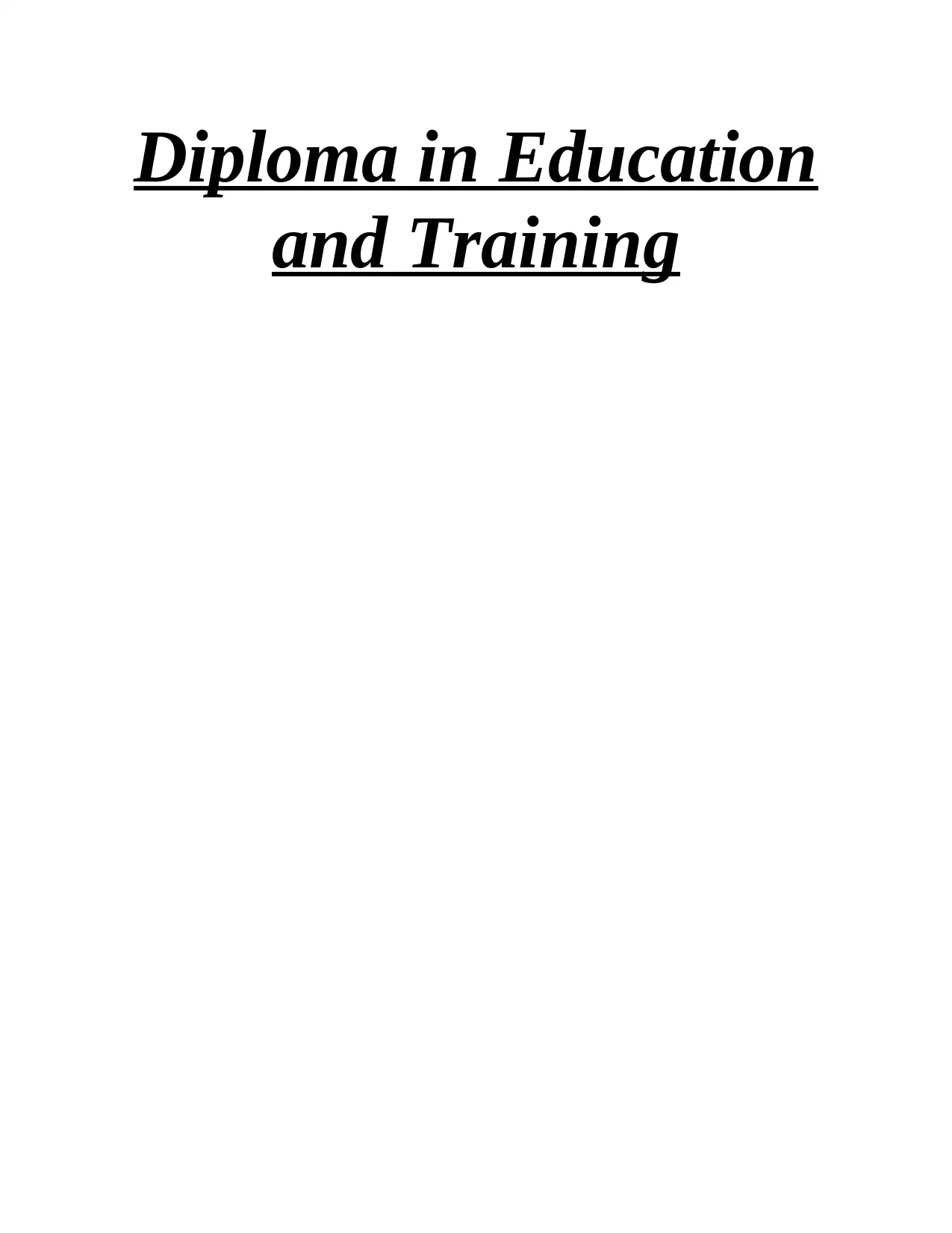
Diploma in Education
and Training
and Training
Paraphrase This Document
Need a fresh take? Get an instant paraphrase of this document with our AI Paraphraser
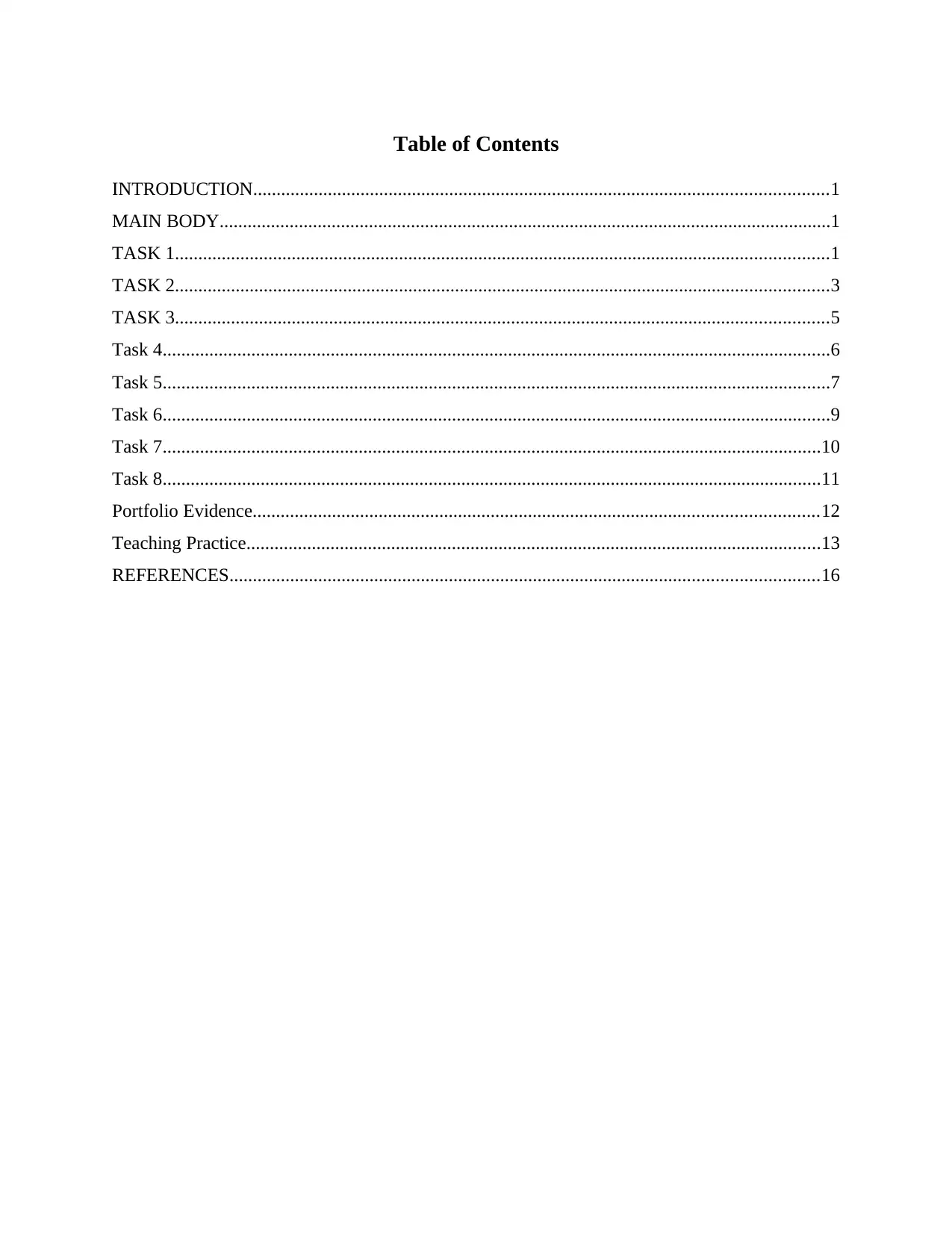
Table of Contents
INTRODUCTION...........................................................................................................................1
MAIN BODY...................................................................................................................................1
TASK 1............................................................................................................................................1
TASK 2............................................................................................................................................3
TASK 3............................................................................................................................................5
Task 4...............................................................................................................................................6
Task 5...............................................................................................................................................7
Task 6...............................................................................................................................................9
Task 7.............................................................................................................................................10
Task 8.............................................................................................................................................11
Portfolio Evidence.........................................................................................................................12
Teaching Practice...........................................................................................................................13
REFERENCES..............................................................................................................................16
INTRODUCTION...........................................................................................................................1
MAIN BODY...................................................................................................................................1
TASK 1............................................................................................................................................1
TASK 2............................................................................................................................................3
TASK 3............................................................................................................................................5
Task 4...............................................................................................................................................6
Task 5...............................................................................................................................................7
Task 6...............................................................................................................................................9
Task 7.............................................................................................................................................10
Task 8.............................................................................................................................................11
Portfolio Evidence.........................................................................................................................12
Teaching Practice...........................................................................................................................13
REFERENCES..............................................................................................................................16
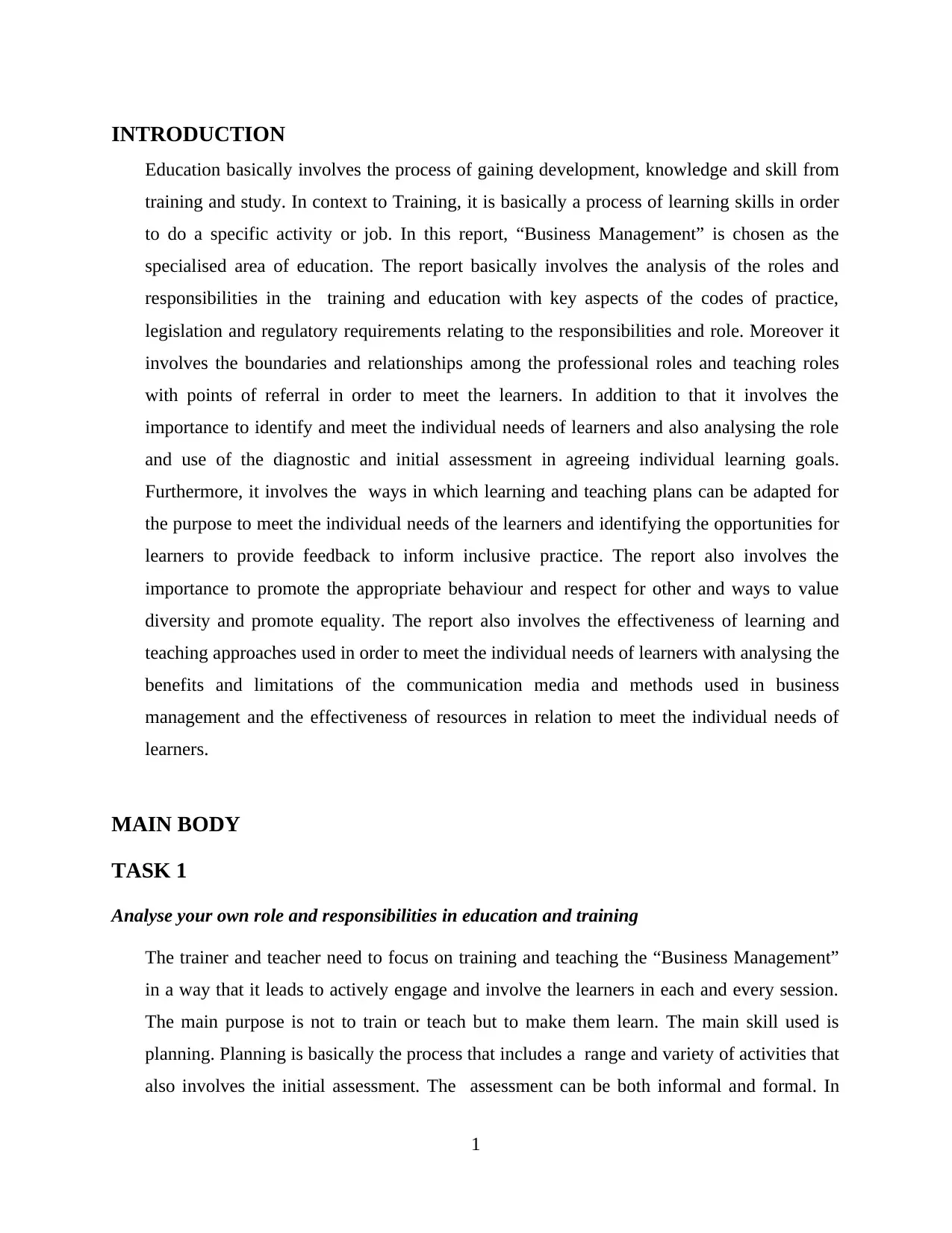
INTRODUCTION
Education basically involves the process of gaining development, knowledge and skill from
training and study. In context to Training, it is basically a process of learning skills in order
to do a specific activity or job. In this report, “Business Management” is chosen as the
specialised area of education. The report basically involves the analysis of the roles and
responsibilities in the training and education with key aspects of the codes of practice,
legislation and regulatory requirements relating to the responsibilities and role. Moreover it
involves the boundaries and relationships among the professional roles and teaching roles
with points of referral in order to meet the learners. In addition to that it involves the
importance to identify and meet the individual needs of learners and also analysing the role
and use of the diagnostic and initial assessment in agreeing individual learning goals.
Furthermore, it involves the ways in which learning and teaching plans can be adapted for
the purpose to meet the individual needs of the learners and identifying the opportunities for
learners to provide feedback to inform inclusive practice. The report also involves the
importance to promote the appropriate behaviour and respect for other and ways to value
diversity and promote equality. The report also involves the effectiveness of learning and
teaching approaches used in order to meet the individual needs of learners with analysing the
benefits and limitations of the communication media and methods used in business
management and the effectiveness of resources in relation to meet the individual needs of
learners.
MAIN BODY
TASK 1
Analyse your own role and responsibilities in education and training
The trainer and teacher need to focus on training and teaching the “Business Management”
in a way that it leads to actively engage and involve the learners in each and every session.
The main purpose is not to train or teach but to make them learn. The main skill used is
planning. Planning is basically the process that includes a range and variety of activities that
also involves the initial assessment. The assessment can be both informal and formal. In
1
Education basically involves the process of gaining development, knowledge and skill from
training and study. In context to Training, it is basically a process of learning skills in order
to do a specific activity or job. In this report, “Business Management” is chosen as the
specialised area of education. The report basically involves the analysis of the roles and
responsibilities in the training and education with key aspects of the codes of practice,
legislation and regulatory requirements relating to the responsibilities and role. Moreover it
involves the boundaries and relationships among the professional roles and teaching roles
with points of referral in order to meet the learners. In addition to that it involves the
importance to identify and meet the individual needs of learners and also analysing the role
and use of the diagnostic and initial assessment in agreeing individual learning goals.
Furthermore, it involves the ways in which learning and teaching plans can be adapted for
the purpose to meet the individual needs of the learners and identifying the opportunities for
learners to provide feedback to inform inclusive practice. The report also involves the
importance to promote the appropriate behaviour and respect for other and ways to value
diversity and promote equality. The report also involves the effectiveness of learning and
teaching approaches used in order to meet the individual needs of learners with analysing the
benefits and limitations of the communication media and methods used in business
management and the effectiveness of resources in relation to meet the individual needs of
learners.
MAIN BODY
TASK 1
Analyse your own role and responsibilities in education and training
The trainer and teacher need to focus on training and teaching the “Business Management”
in a way that it leads to actively engage and involve the learners in each and every session.
The main purpose is not to train or teach but to make them learn. The main skill used is
planning. Planning is basically the process that includes a range and variety of activities that
also involves the initial assessment. The assessment can be both informal and formal. In
1
⊘ This is a preview!⊘
Do you want full access?
Subscribe today to unlock all pages.

Trusted by 1+ million students worldwide
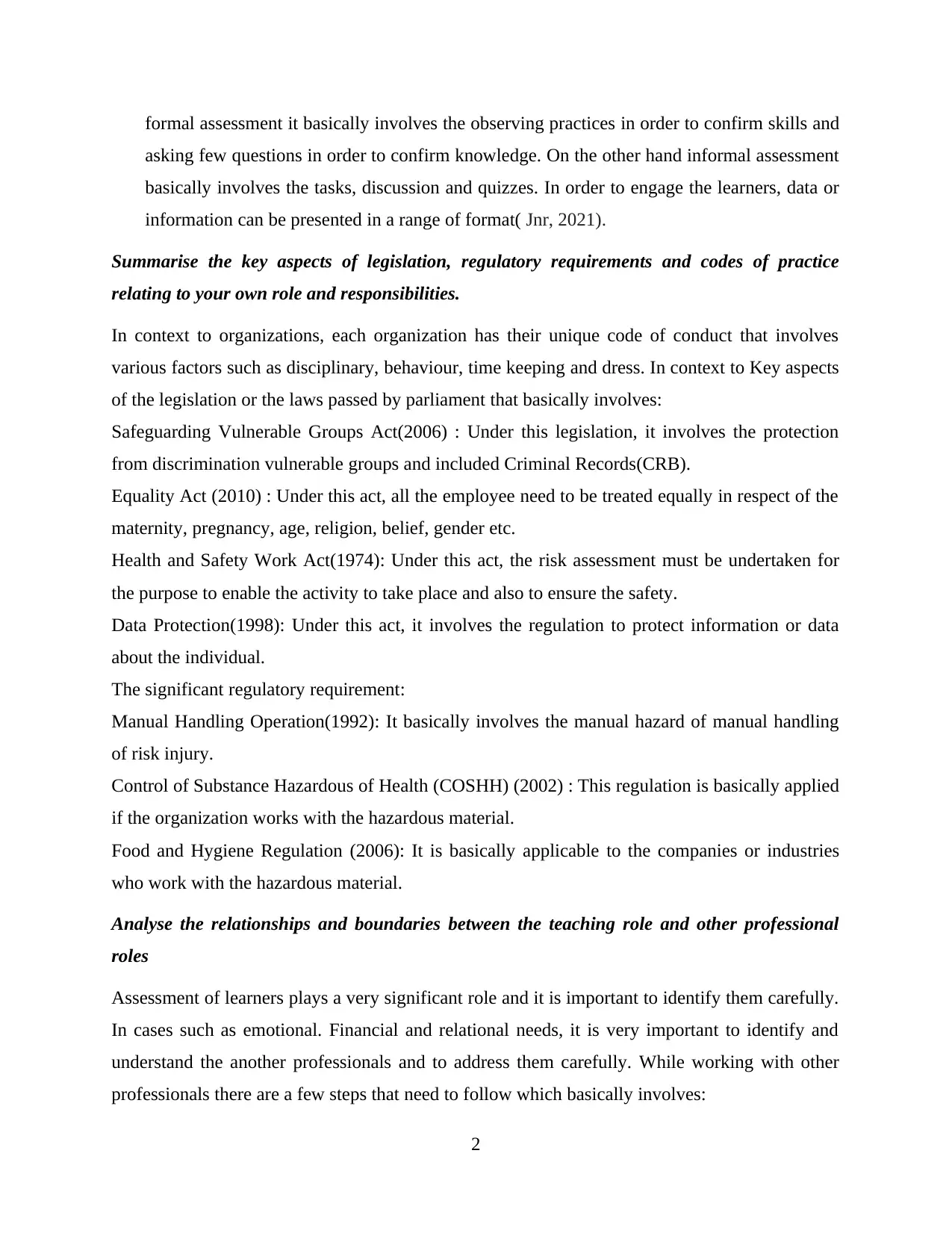
formal assessment it basically involves the observing practices in order to confirm skills and
asking few questions in order to confirm knowledge. On the other hand informal assessment
basically involves the tasks, discussion and quizzes. In order to engage the learners, data or
information can be presented in a range of format( Jnr, 2021).
Summarise the key aspects of legislation, regulatory requirements and codes of practice
relating to your own role and responsibilities.
In context to organizations, each organization has their unique code of conduct that involves
various factors such as disciplinary, behaviour, time keeping and dress. In context to Key aspects
of the legislation or the laws passed by parliament that basically involves:
Safeguarding Vulnerable Groups Act(2006) : Under this legislation, it involves the protection
from discrimination vulnerable groups and included Criminal Records(CRB).
Equality Act (2010) : Under this act, all the employee need to be treated equally in respect of the
maternity, pregnancy, age, religion, belief, gender etc.
Health and Safety Work Act(1974): Under this act, the risk assessment must be undertaken for
the purpose to enable the activity to take place and also to ensure the safety.
Data Protection(1998): Under this act, it involves the regulation to protect information or data
about the individual.
The significant regulatory requirement:
Manual Handling Operation(1992): It basically involves the manual hazard of manual handling
of risk injury.
Control of Substance Hazardous of Health (COSHH) (2002) : This regulation is basically applied
if the organization works with the hazardous material.
Food and Hygiene Regulation (2006): It is basically applicable to the companies or industries
who work with the hazardous material.
Analyse the relationships and boundaries between the teaching role and other professional
roles
Assessment of learners plays a very significant role and it is important to identify them carefully.
In cases such as emotional. Financial and relational needs, it is very important to identify and
understand the another professionals and to address them carefully. While working with other
professionals there are a few steps that need to follow which basically involves:
2
asking few questions in order to confirm knowledge. On the other hand informal assessment
basically involves the tasks, discussion and quizzes. In order to engage the learners, data or
information can be presented in a range of format( Jnr, 2021).
Summarise the key aspects of legislation, regulatory requirements and codes of practice
relating to your own role and responsibilities.
In context to organizations, each organization has their unique code of conduct that involves
various factors such as disciplinary, behaviour, time keeping and dress. In context to Key aspects
of the legislation or the laws passed by parliament that basically involves:
Safeguarding Vulnerable Groups Act(2006) : Under this legislation, it involves the protection
from discrimination vulnerable groups and included Criminal Records(CRB).
Equality Act (2010) : Under this act, all the employee need to be treated equally in respect of the
maternity, pregnancy, age, religion, belief, gender etc.
Health and Safety Work Act(1974): Under this act, the risk assessment must be undertaken for
the purpose to enable the activity to take place and also to ensure the safety.
Data Protection(1998): Under this act, it involves the regulation to protect information or data
about the individual.
The significant regulatory requirement:
Manual Handling Operation(1992): It basically involves the manual hazard of manual handling
of risk injury.
Control of Substance Hazardous of Health (COSHH) (2002) : This regulation is basically applied
if the organization works with the hazardous material.
Food and Hygiene Regulation (2006): It is basically applicable to the companies or industries
who work with the hazardous material.
Analyse the relationships and boundaries between the teaching role and other professional
roles
Assessment of learners plays a very significant role and it is important to identify them carefully.
In cases such as emotional. Financial and relational needs, it is very important to identify and
understand the another professionals and to address them carefully. While working with other
professionals there are a few steps that need to follow which basically involves:
2
Paraphrase This Document
Need a fresh take? Get an instant paraphrase of this document with our AI Paraphraser
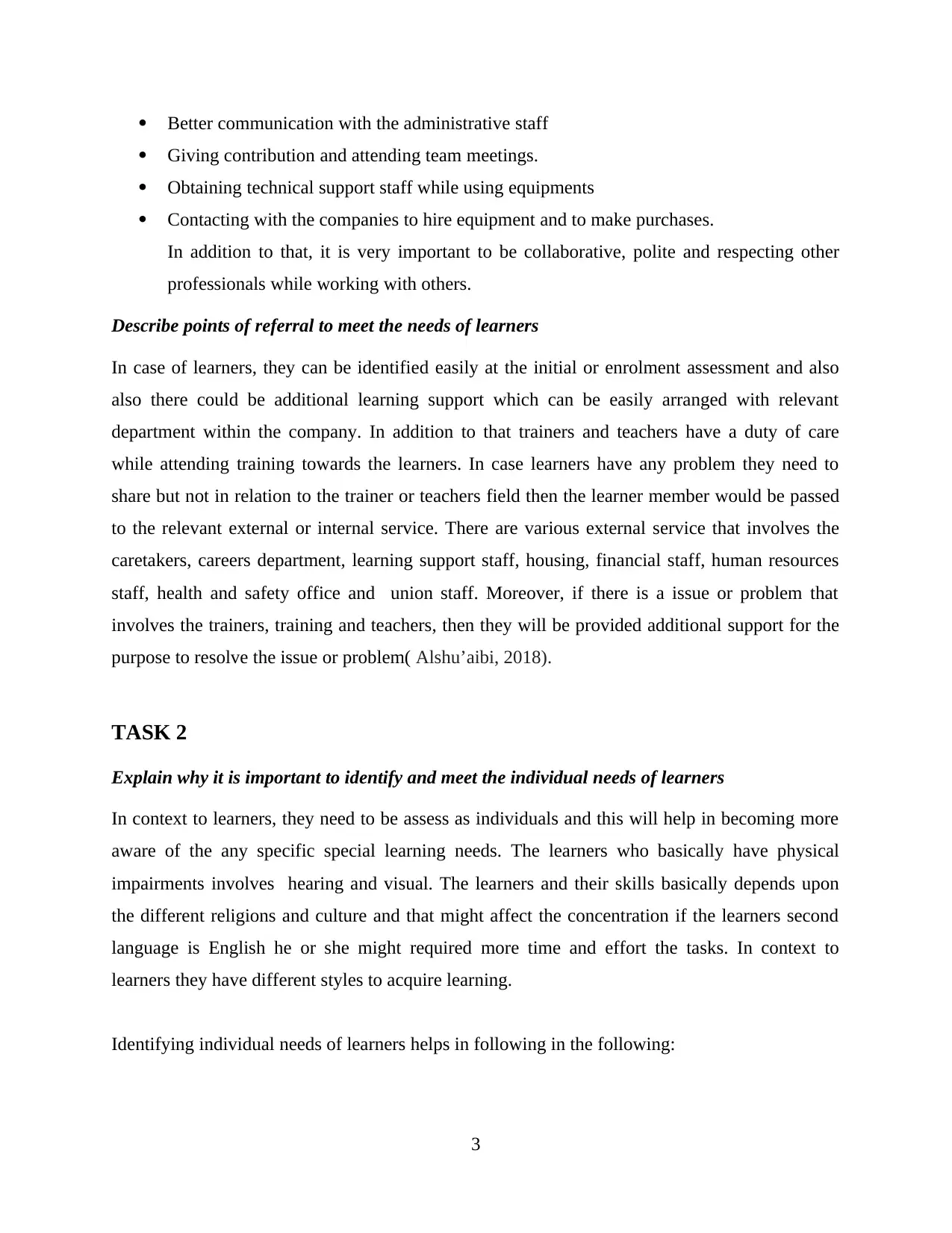
Better communication with the administrative staff
Giving contribution and attending team meetings.
Obtaining technical support staff while using equipments
Contacting with the companies to hire equipment and to make purchases.
In addition to that, it is very important to be collaborative, polite and respecting other
professionals while working with others.
Describe points of referral to meet the needs of learners
In case of learners, they can be identified easily at the initial or enrolment assessment and also
also there could be additional learning support which can be easily arranged with relevant
department within the company. In addition to that trainers and teachers have a duty of care
while attending training towards the learners. In case learners have any problem they need to
share but not in relation to the trainer or teachers field then the learner member would be passed
to the relevant external or internal service. There are various external service that involves the
caretakers, careers department, learning support staff, housing, financial staff, human resources
staff, health and safety office and union staff. Moreover, if there is a issue or problem that
involves the trainers, training and teachers, then they will be provided additional support for the
purpose to resolve the issue or problem( Alshu’aibi, 2018).
TASK 2
Explain why it is important to identify and meet the individual needs of learners
In context to learners, they need to be assess as individuals and this will help in becoming more
aware of the any specific special learning needs. The learners who basically have physical
impairments involves hearing and visual. The learners and their skills basically depends upon
the different religions and culture and that might affect the concentration if the learners second
language is English he or she might required more time and effort the tasks. In context to
learners they have different styles to acquire learning.
Identifying individual needs of learners helps in following in the following:
3
Giving contribution and attending team meetings.
Obtaining technical support staff while using equipments
Contacting with the companies to hire equipment and to make purchases.
In addition to that, it is very important to be collaborative, polite and respecting other
professionals while working with others.
Describe points of referral to meet the needs of learners
In case of learners, they can be identified easily at the initial or enrolment assessment and also
also there could be additional learning support which can be easily arranged with relevant
department within the company. In addition to that trainers and teachers have a duty of care
while attending training towards the learners. In case learners have any problem they need to
share but not in relation to the trainer or teachers field then the learner member would be passed
to the relevant external or internal service. There are various external service that involves the
caretakers, careers department, learning support staff, housing, financial staff, human resources
staff, health and safety office and union staff. Moreover, if there is a issue or problem that
involves the trainers, training and teachers, then they will be provided additional support for the
purpose to resolve the issue or problem( Alshu’aibi, 2018).
TASK 2
Explain why it is important to identify and meet the individual needs of learners
In context to learners, they need to be assess as individuals and this will help in becoming more
aware of the any specific special learning needs. The learners who basically have physical
impairments involves hearing and visual. The learners and their skills basically depends upon
the different religions and culture and that might affect the concentration if the learners second
language is English he or she might required more time and effort the tasks. In context to
learners they have different styles to acquire learning.
Identifying individual needs of learners helps in following in the following:
3
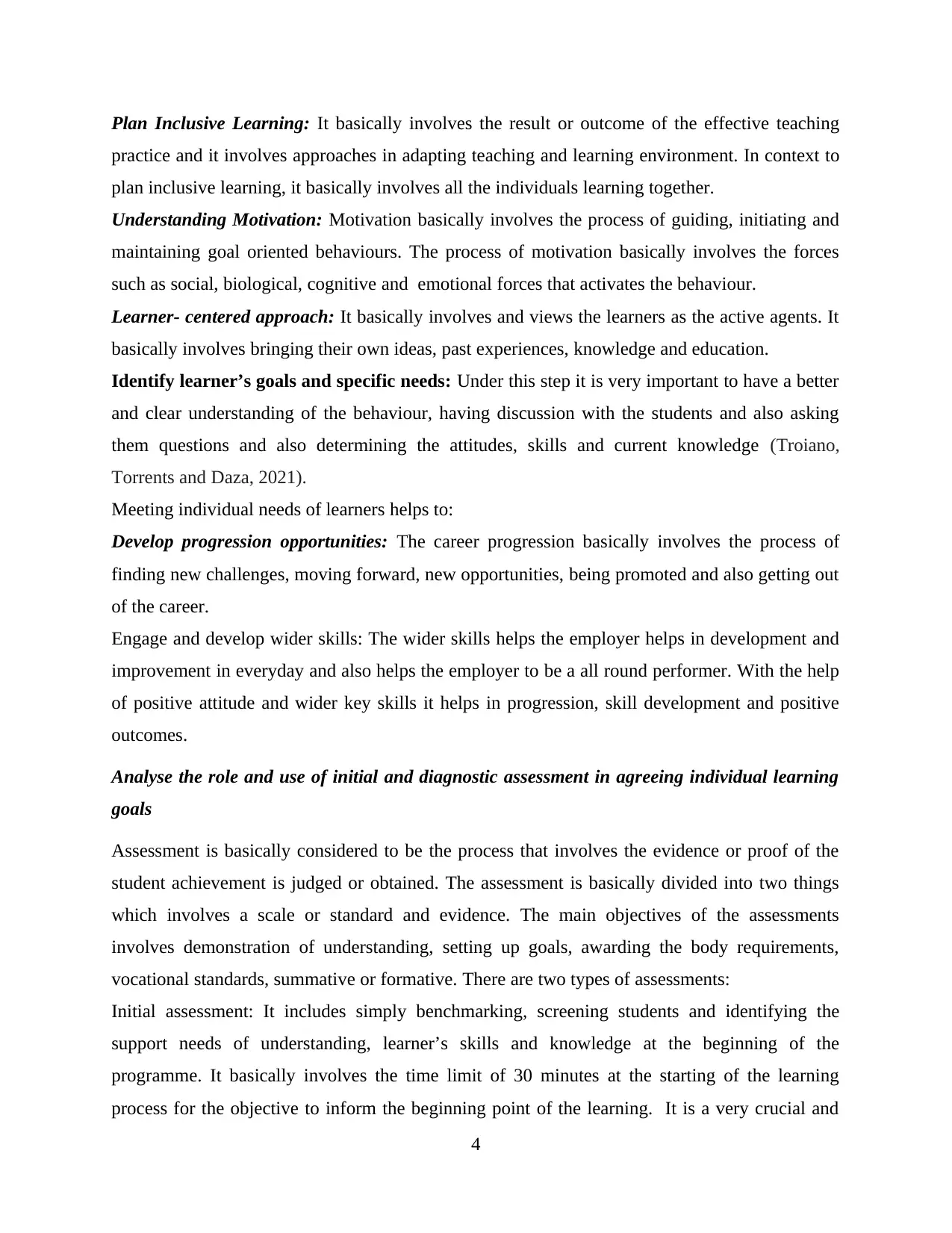
Plan Inclusive Learning: It basically involves the result or outcome of the effective teaching
practice and it involves approaches in adapting teaching and learning environment. In context to
plan inclusive learning, it basically involves all the individuals learning together.
Understanding Motivation: Motivation basically involves the process of guiding, initiating and
maintaining goal oriented behaviours. The process of motivation basically involves the forces
such as social, biological, cognitive and emotional forces that activates the behaviour.
Learner- centered approach: It basically involves and views the learners as the active agents. It
basically involves bringing their own ideas, past experiences, knowledge and education.
Identify learner’s goals and specific needs: Under this step it is very important to have a better
and clear understanding of the behaviour, having discussion with the students and also asking
them questions and also determining the attitudes, skills and current knowledge (Troiano,
Torrents and Daza, 2021).
Meeting individual needs of learners helps to:
Develop progression opportunities: The career progression basically involves the process of
finding new challenges, moving forward, new opportunities, being promoted and also getting out
of the career.
Engage and develop wider skills: The wider skills helps the employer helps in development and
improvement in everyday and also helps the employer to be a all round performer. With the help
of positive attitude and wider key skills it helps in progression, skill development and positive
outcomes.
Analyse the role and use of initial and diagnostic assessment in agreeing individual learning
goals
Assessment is basically considered to be the process that involves the evidence or proof of the
student achievement is judged or obtained. The assessment is basically divided into two things
which involves a scale or standard and evidence. The main objectives of the assessments
involves demonstration of understanding, setting up goals, awarding the body requirements,
vocational standards, summative or formative. There are two types of assessments:
Initial assessment: It includes simply benchmarking, screening students and identifying the
support needs of understanding, learner’s skills and knowledge at the beginning of the
programme. It basically involves the time limit of 30 minutes at the starting of the learning
process for the objective to inform the beginning point of the learning. It is a very crucial and
4
practice and it involves approaches in adapting teaching and learning environment. In context to
plan inclusive learning, it basically involves all the individuals learning together.
Understanding Motivation: Motivation basically involves the process of guiding, initiating and
maintaining goal oriented behaviours. The process of motivation basically involves the forces
such as social, biological, cognitive and emotional forces that activates the behaviour.
Learner- centered approach: It basically involves and views the learners as the active agents. It
basically involves bringing their own ideas, past experiences, knowledge and education.
Identify learner’s goals and specific needs: Under this step it is very important to have a better
and clear understanding of the behaviour, having discussion with the students and also asking
them questions and also determining the attitudes, skills and current knowledge (Troiano,
Torrents and Daza, 2021).
Meeting individual needs of learners helps to:
Develop progression opportunities: The career progression basically involves the process of
finding new challenges, moving forward, new opportunities, being promoted and also getting out
of the career.
Engage and develop wider skills: The wider skills helps the employer helps in development and
improvement in everyday and also helps the employer to be a all round performer. With the help
of positive attitude and wider key skills it helps in progression, skill development and positive
outcomes.
Analyse the role and use of initial and diagnostic assessment in agreeing individual learning
goals
Assessment is basically considered to be the process that involves the evidence or proof of the
student achievement is judged or obtained. The assessment is basically divided into two things
which involves a scale or standard and evidence. The main objectives of the assessments
involves demonstration of understanding, setting up goals, awarding the body requirements,
vocational standards, summative or formative. There are two types of assessments:
Initial assessment: It includes simply benchmarking, screening students and identifying the
support needs of understanding, learner’s skills and knowledge at the beginning of the
programme. It basically involves the time limit of 30 minutes at the starting of the learning
process for the objective to inform the beginning point of the learning. It is a very crucial and
4
⊘ This is a preview!⊘
Do you want full access?
Subscribe today to unlock all pages.

Trusted by 1+ million students worldwide
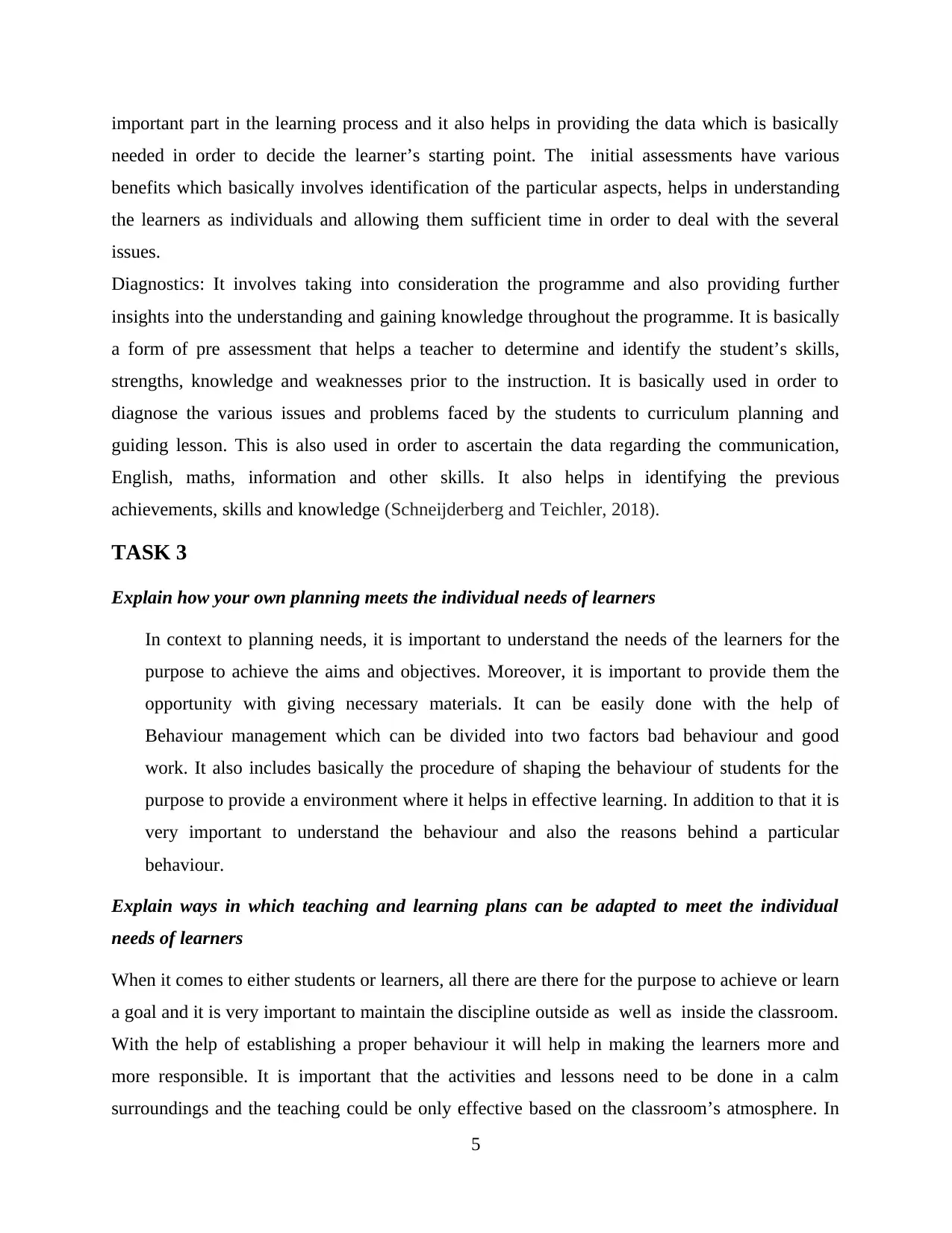
important part in the learning process and it also helps in providing the data which is basically
needed in order to decide the learner’s starting point. The initial assessments have various
benefits which basically involves identification of the particular aspects, helps in understanding
the learners as individuals and allowing them sufficient time in order to deal with the several
issues.
Diagnostics: It involves taking into consideration the programme and also providing further
insights into the understanding and gaining knowledge throughout the programme. It is basically
a form of pre assessment that helps a teacher to determine and identify the student’s skills,
strengths, knowledge and weaknesses prior to the instruction. It is basically used in order to
diagnose the various issues and problems faced by the students to curriculum planning and
guiding lesson. This is also used in order to ascertain the data regarding the communication,
English, maths, information and other skills. It also helps in identifying the previous
achievements, skills and knowledge (Schneijderberg and Teichler, 2018).
TASK 3
Explain how your own planning meets the individual needs of learners
In context to planning needs, it is important to understand the needs of the learners for the
purpose to achieve the aims and objectives. Moreover, it is important to provide them the
opportunity with giving necessary materials. It can be easily done with the help of
Behaviour management which can be divided into two factors bad behaviour and good
work. It also includes basically the procedure of shaping the behaviour of students for the
purpose to provide a environment where it helps in effective learning. In addition to that it is
very important to understand the behaviour and also the reasons behind a particular
behaviour.
Explain ways in which teaching and learning plans can be adapted to meet the individual
needs of learners
When it comes to either students or learners, all there are there for the purpose to achieve or learn
a goal and it is very important to maintain the discipline outside as well as inside the classroom.
With the help of establishing a proper behaviour it will help in making the learners more and
more responsible. It is important that the activities and lessons need to be done in a calm
surroundings and the teaching could be only effective based on the classroom’s atmosphere. In
5
needed in order to decide the learner’s starting point. The initial assessments have various
benefits which basically involves identification of the particular aspects, helps in understanding
the learners as individuals and allowing them sufficient time in order to deal with the several
issues.
Diagnostics: It involves taking into consideration the programme and also providing further
insights into the understanding and gaining knowledge throughout the programme. It is basically
a form of pre assessment that helps a teacher to determine and identify the student’s skills,
strengths, knowledge and weaknesses prior to the instruction. It is basically used in order to
diagnose the various issues and problems faced by the students to curriculum planning and
guiding lesson. This is also used in order to ascertain the data regarding the communication,
English, maths, information and other skills. It also helps in identifying the previous
achievements, skills and knowledge (Schneijderberg and Teichler, 2018).
TASK 3
Explain how your own planning meets the individual needs of learners
In context to planning needs, it is important to understand the needs of the learners for the
purpose to achieve the aims and objectives. Moreover, it is important to provide them the
opportunity with giving necessary materials. It can be easily done with the help of
Behaviour management which can be divided into two factors bad behaviour and good
work. It also includes basically the procedure of shaping the behaviour of students for the
purpose to provide a environment where it helps in effective learning. In addition to that it is
very important to understand the behaviour and also the reasons behind a particular
behaviour.
Explain ways in which teaching and learning plans can be adapted to meet the individual
needs of learners
When it comes to either students or learners, all there are there for the purpose to achieve or learn
a goal and it is very important to maintain the discipline outside as well as inside the classroom.
With the help of establishing a proper behaviour it will help in making the learners more and
more responsible. It is important that the activities and lessons need to be done in a calm
surroundings and the teaching could be only effective based on the classroom’s atmosphere. In
5
Paraphrase This Document
Need a fresh take? Get an instant paraphrase of this document with our AI Paraphraser
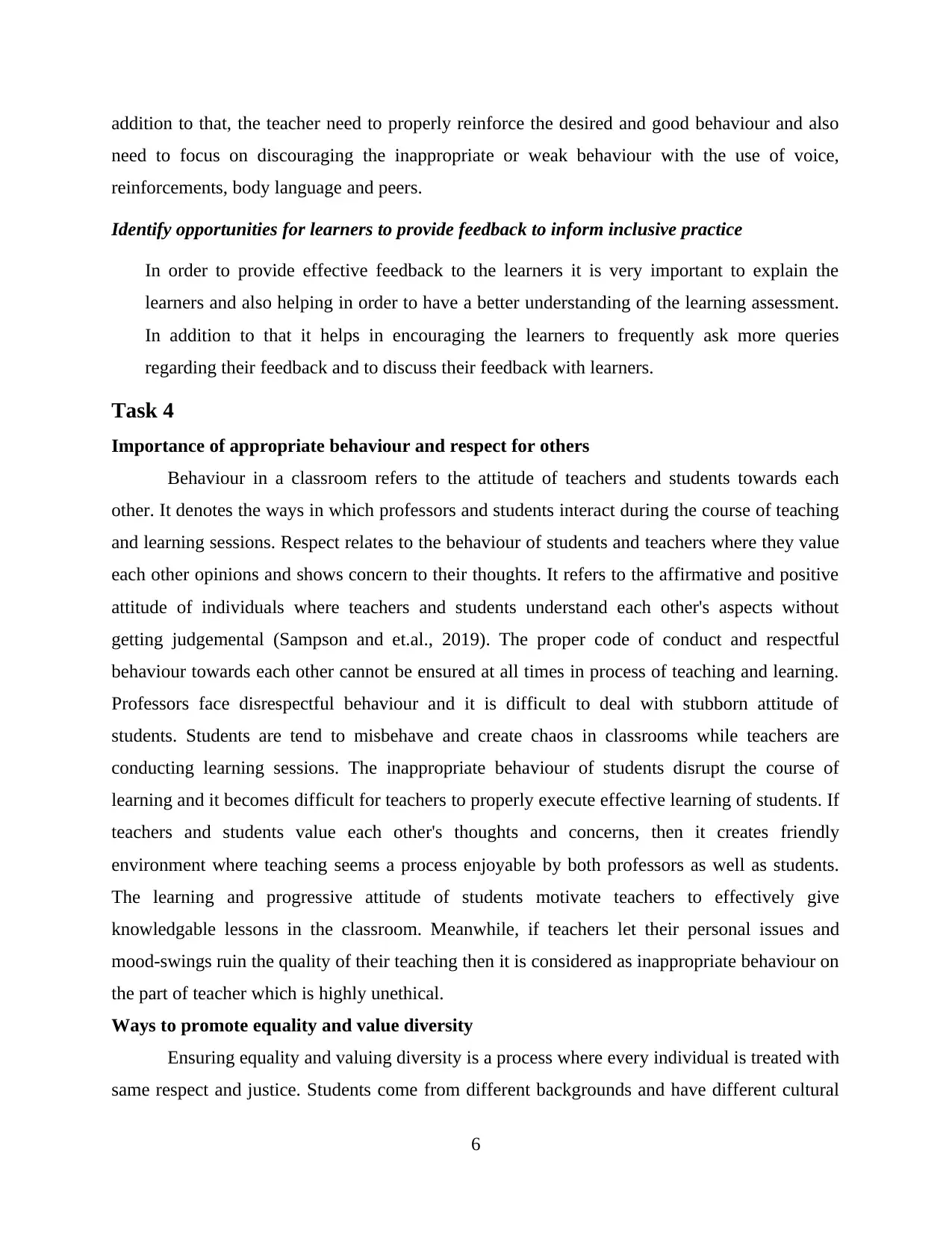
addition to that, the teacher need to properly reinforce the desired and good behaviour and also
need to focus on discouraging the inappropriate or weak behaviour with the use of voice,
reinforcements, body language and peers.
Identify opportunities for learners to provide feedback to inform inclusive practice
In order to provide effective feedback to the learners it is very important to explain the
learners and also helping in order to have a better understanding of the learning assessment.
In addition to that it helps in encouraging the learners to frequently ask more queries
regarding their feedback and to discuss their feedback with learners.
Task 4
Importance of appropriate behaviour and respect for others
Behaviour in a classroom refers to the attitude of teachers and students towards each
other. It denotes the ways in which professors and students interact during the course of teaching
and learning sessions. Respect relates to the behaviour of students and teachers where they value
each other opinions and shows concern to their thoughts. It refers to the affirmative and positive
attitude of individuals where teachers and students understand each other's aspects without
getting judgemental (Sampson and et.al., 2019). The proper code of conduct and respectful
behaviour towards each other cannot be ensured at all times in process of teaching and learning.
Professors face disrespectful behaviour and it is difficult to deal with stubborn attitude of
students. Students are tend to misbehave and create chaos in classrooms while teachers are
conducting learning sessions. The inappropriate behaviour of students disrupt the course of
learning and it becomes difficult for teachers to properly execute effective learning of students. If
teachers and students value each other's thoughts and concerns, then it creates friendly
environment where teaching seems a process enjoyable by both professors as well as students.
The learning and progressive attitude of students motivate teachers to effectively give
knowledgable lessons in the classroom. Meanwhile, if teachers let their personal issues and
mood-swings ruin the quality of their teaching then it is considered as inappropriate behaviour on
the part of teacher which is highly unethical.
Ways to promote equality and value diversity
Ensuring equality and valuing diversity is a process where every individual is treated with
same respect and justice. Students come from different backgrounds and have different cultural
6
need to focus on discouraging the inappropriate or weak behaviour with the use of voice,
reinforcements, body language and peers.
Identify opportunities for learners to provide feedback to inform inclusive practice
In order to provide effective feedback to the learners it is very important to explain the
learners and also helping in order to have a better understanding of the learning assessment.
In addition to that it helps in encouraging the learners to frequently ask more queries
regarding their feedback and to discuss their feedback with learners.
Task 4
Importance of appropriate behaviour and respect for others
Behaviour in a classroom refers to the attitude of teachers and students towards each
other. It denotes the ways in which professors and students interact during the course of teaching
and learning sessions. Respect relates to the behaviour of students and teachers where they value
each other opinions and shows concern to their thoughts. It refers to the affirmative and positive
attitude of individuals where teachers and students understand each other's aspects without
getting judgemental (Sampson and et.al., 2019). The proper code of conduct and respectful
behaviour towards each other cannot be ensured at all times in process of teaching and learning.
Professors face disrespectful behaviour and it is difficult to deal with stubborn attitude of
students. Students are tend to misbehave and create chaos in classrooms while teachers are
conducting learning sessions. The inappropriate behaviour of students disrupt the course of
learning and it becomes difficult for teachers to properly execute effective learning of students. If
teachers and students value each other's thoughts and concerns, then it creates friendly
environment where teaching seems a process enjoyable by both professors as well as students.
The learning and progressive attitude of students motivate teachers to effectively give
knowledgable lessons in the classroom. Meanwhile, if teachers let their personal issues and
mood-swings ruin the quality of their teaching then it is considered as inappropriate behaviour on
the part of teacher which is highly unethical.
Ways to promote equality and value diversity
Ensuring equality and valuing diversity is a process where every individual is treated with
same respect and justice. Students come from different backgrounds and have different cultural
6
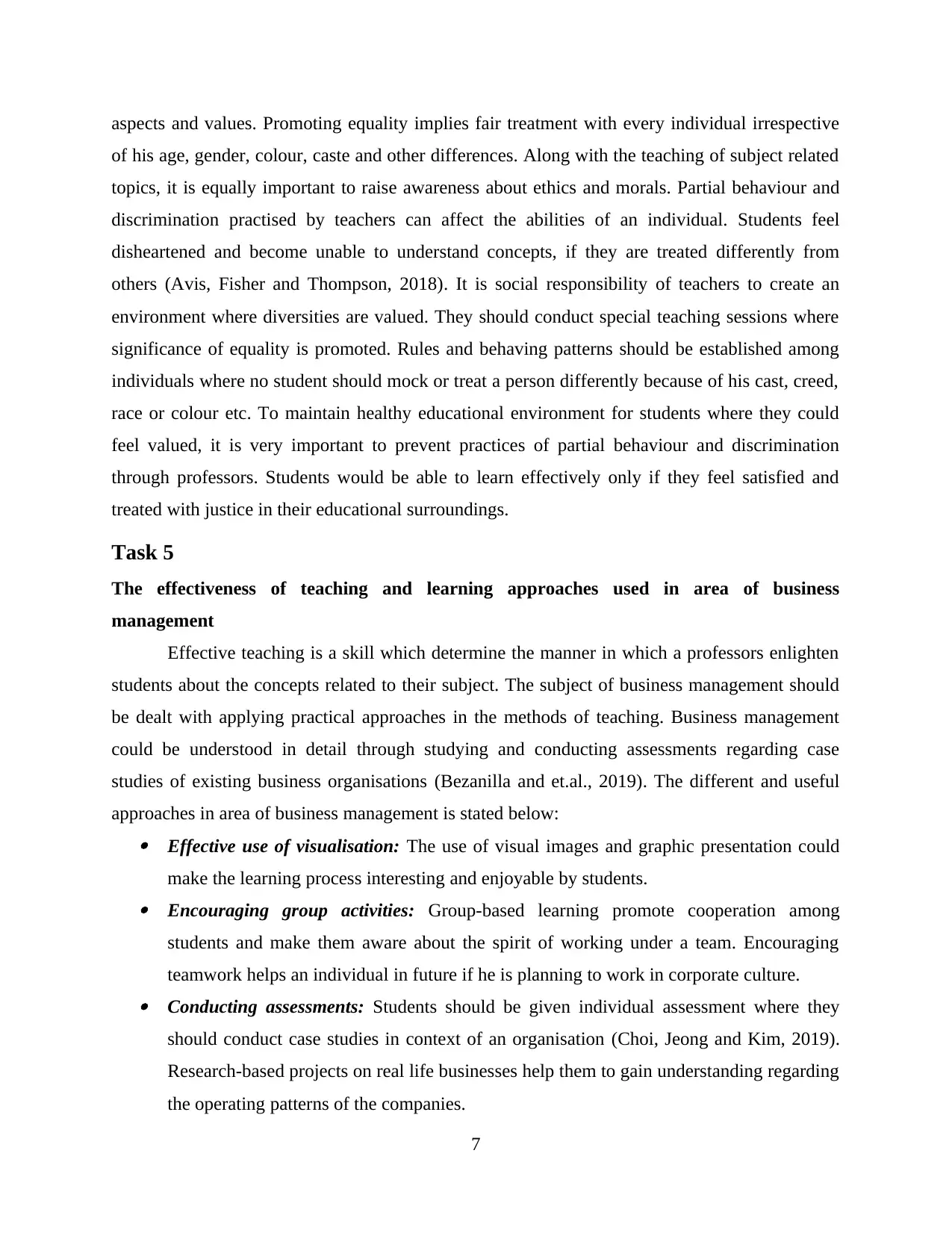
aspects and values. Promoting equality implies fair treatment with every individual irrespective
of his age, gender, colour, caste and other differences. Along with the teaching of subject related
topics, it is equally important to raise awareness about ethics and morals. Partial behaviour and
discrimination practised by teachers can affect the abilities of an individual. Students feel
disheartened and become unable to understand concepts, if they are treated differently from
others (Avis, Fisher and Thompson, 2018). It is social responsibility of teachers to create an
environment where diversities are valued. They should conduct special teaching sessions where
significance of equality is promoted. Rules and behaving patterns should be established among
individuals where no student should mock or treat a person differently because of his cast, creed,
race or colour etc. To maintain healthy educational environment for students where they could
feel valued, it is very important to prevent practices of partial behaviour and discrimination
through professors. Students would be able to learn effectively only if they feel satisfied and
treated with justice in their educational surroundings.
Task 5
The effectiveness of teaching and learning approaches used in area of business
management
Effective teaching is a skill which determine the manner in which a professors enlighten
students about the concepts related to their subject. The subject of business management should
be dealt with applying practical approaches in the methods of teaching. Business management
could be understood in detail through studying and conducting assessments regarding case
studies of existing business organisations (Bezanilla and et.al., 2019). The different and useful
approaches in area of business management is stated below: Effective use of visualisation: The use of visual images and graphic presentation could
make the learning process interesting and enjoyable by students. Encouraging group activities: Group-based learning promote cooperation among
students and make them aware about the spirit of working under a team. Encouraging
teamwork helps an individual in future if he is planning to work in corporate culture. Conducting assessments: Students should be given individual assessment where they
should conduct case studies in context of an organisation (Choi, Jeong and Kim, 2019).
Research-based projects on real life businesses help them to gain understanding regarding
the operating patterns of the companies.
7
of his age, gender, colour, caste and other differences. Along with the teaching of subject related
topics, it is equally important to raise awareness about ethics and morals. Partial behaviour and
discrimination practised by teachers can affect the abilities of an individual. Students feel
disheartened and become unable to understand concepts, if they are treated differently from
others (Avis, Fisher and Thompson, 2018). It is social responsibility of teachers to create an
environment where diversities are valued. They should conduct special teaching sessions where
significance of equality is promoted. Rules and behaving patterns should be established among
individuals where no student should mock or treat a person differently because of his cast, creed,
race or colour etc. To maintain healthy educational environment for students where they could
feel valued, it is very important to prevent practices of partial behaviour and discrimination
through professors. Students would be able to learn effectively only if they feel satisfied and
treated with justice in their educational surroundings.
Task 5
The effectiveness of teaching and learning approaches used in area of business
management
Effective teaching is a skill which determine the manner in which a professors enlighten
students about the concepts related to their subject. The subject of business management should
be dealt with applying practical approaches in the methods of teaching. Business management
could be understood in detail through studying and conducting assessments regarding case
studies of existing business organisations (Bezanilla and et.al., 2019). The different and useful
approaches in area of business management is stated below: Effective use of visualisation: The use of visual images and graphic presentation could
make the learning process interesting and enjoyable by students. Encouraging group activities: Group-based learning promote cooperation among
students and make them aware about the spirit of working under a team. Encouraging
teamwork helps an individual in future if he is planning to work in corporate culture. Conducting assessments: Students should be given individual assessment where they
should conduct case studies in context of an organisation (Choi, Jeong and Kim, 2019).
Research-based projects on real life businesses help them to gain understanding regarding
the operating patterns of the companies.
7
⊘ This is a preview!⊘
Do you want full access?
Subscribe today to unlock all pages.

Trusted by 1+ million students worldwide
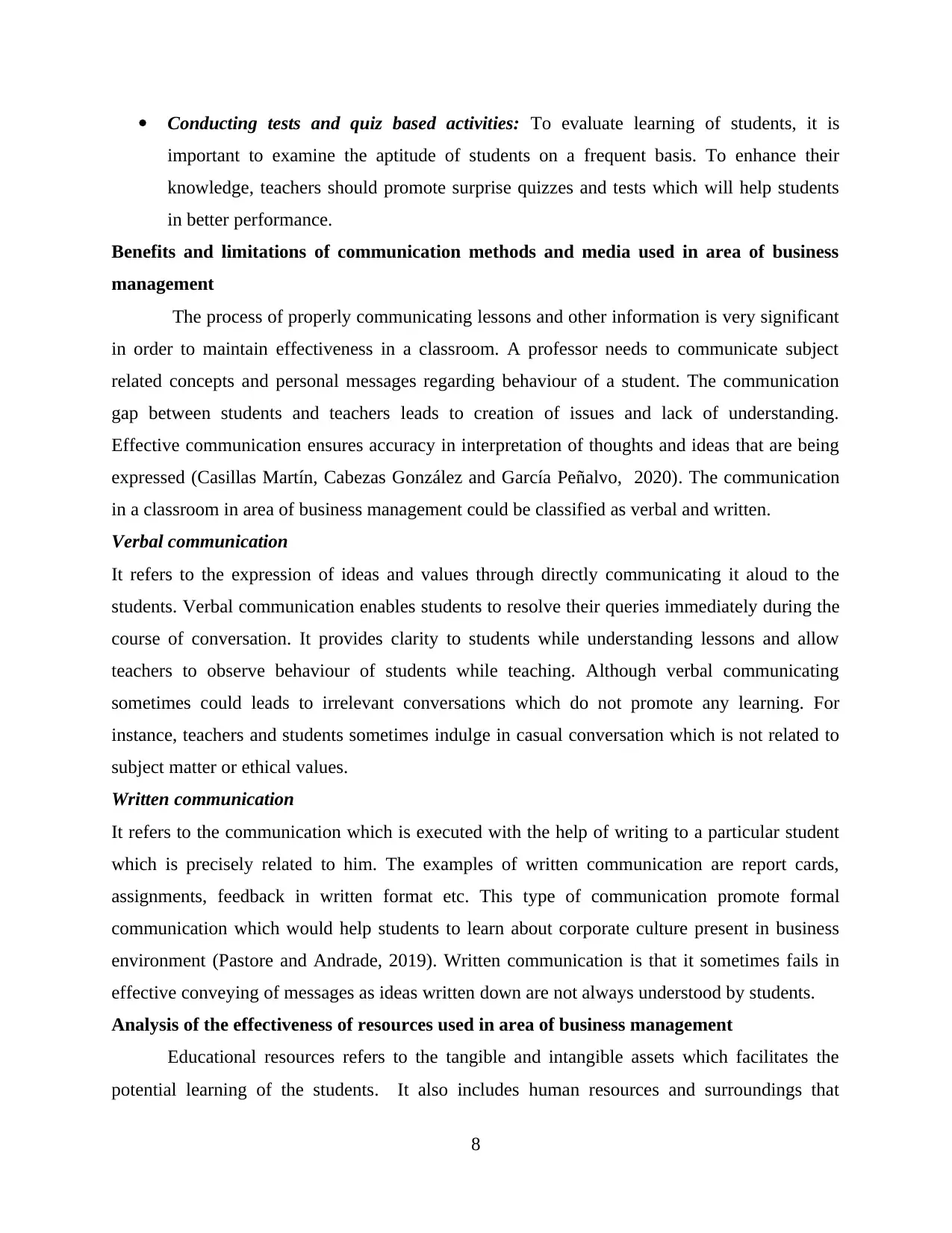
Conducting tests and quiz based activities: To evaluate learning of students, it is
important to examine the aptitude of students on a frequent basis. To enhance their
knowledge, teachers should promote surprise quizzes and tests which will help students
in better performance.
Benefits and limitations of communication methods and media used in area of business
management
The process of properly communicating lessons and other information is very significant
in order to maintain effectiveness in a classroom. A professor needs to communicate subject
related concepts and personal messages regarding behaviour of a student. The communication
gap between students and teachers leads to creation of issues and lack of understanding.
Effective communication ensures accuracy in interpretation of thoughts and ideas that are being
expressed (Casillas Martín, Cabezas González and García Peñalvo, 2020). The communication
in a classroom in area of business management could be classified as verbal and written.
Verbal communication
It refers to the expression of ideas and values through directly communicating it aloud to the
students. Verbal communication enables students to resolve their queries immediately during the
course of conversation. It provides clarity to students while understanding lessons and allow
teachers to observe behaviour of students while teaching. Although verbal communicating
sometimes could leads to irrelevant conversations which do not promote any learning. For
instance, teachers and students sometimes indulge in casual conversation which is not related to
subject matter or ethical values.
Written communication
It refers to the communication which is executed with the help of writing to a particular student
which is precisely related to him. The examples of written communication are report cards,
assignments, feedback in written format etc. This type of communication promote formal
communication which would help students to learn about corporate culture present in business
environment (Pastore and Andrade, 2019). Written communication is that it sometimes fails in
effective conveying of messages as ideas written down are not always understood by students.
Analysis of the effectiveness of resources used in area of business management
Educational resources refers to the tangible and intangible assets which facilitates the
potential learning of the students. It also includes human resources and surroundings that
8
important to examine the aptitude of students on a frequent basis. To enhance their
knowledge, teachers should promote surprise quizzes and tests which will help students
in better performance.
Benefits and limitations of communication methods and media used in area of business
management
The process of properly communicating lessons and other information is very significant
in order to maintain effectiveness in a classroom. A professor needs to communicate subject
related concepts and personal messages regarding behaviour of a student. The communication
gap between students and teachers leads to creation of issues and lack of understanding.
Effective communication ensures accuracy in interpretation of thoughts and ideas that are being
expressed (Casillas Martín, Cabezas González and García Peñalvo, 2020). The communication
in a classroom in area of business management could be classified as verbal and written.
Verbal communication
It refers to the expression of ideas and values through directly communicating it aloud to the
students. Verbal communication enables students to resolve their queries immediately during the
course of conversation. It provides clarity to students while understanding lessons and allow
teachers to observe behaviour of students while teaching. Although verbal communicating
sometimes could leads to irrelevant conversations which do not promote any learning. For
instance, teachers and students sometimes indulge in casual conversation which is not related to
subject matter or ethical values.
Written communication
It refers to the communication which is executed with the help of writing to a particular student
which is precisely related to him. The examples of written communication are report cards,
assignments, feedback in written format etc. This type of communication promote formal
communication which would help students to learn about corporate culture present in business
environment (Pastore and Andrade, 2019). Written communication is that it sometimes fails in
effective conveying of messages as ideas written down are not always understood by students.
Analysis of the effectiveness of resources used in area of business management
Educational resources refers to the tangible and intangible assets which facilitates the
potential learning of the students. It also includes human resources and surroundings that
8
Paraphrase This Document
Need a fresh take? Get an instant paraphrase of this document with our AI Paraphraser
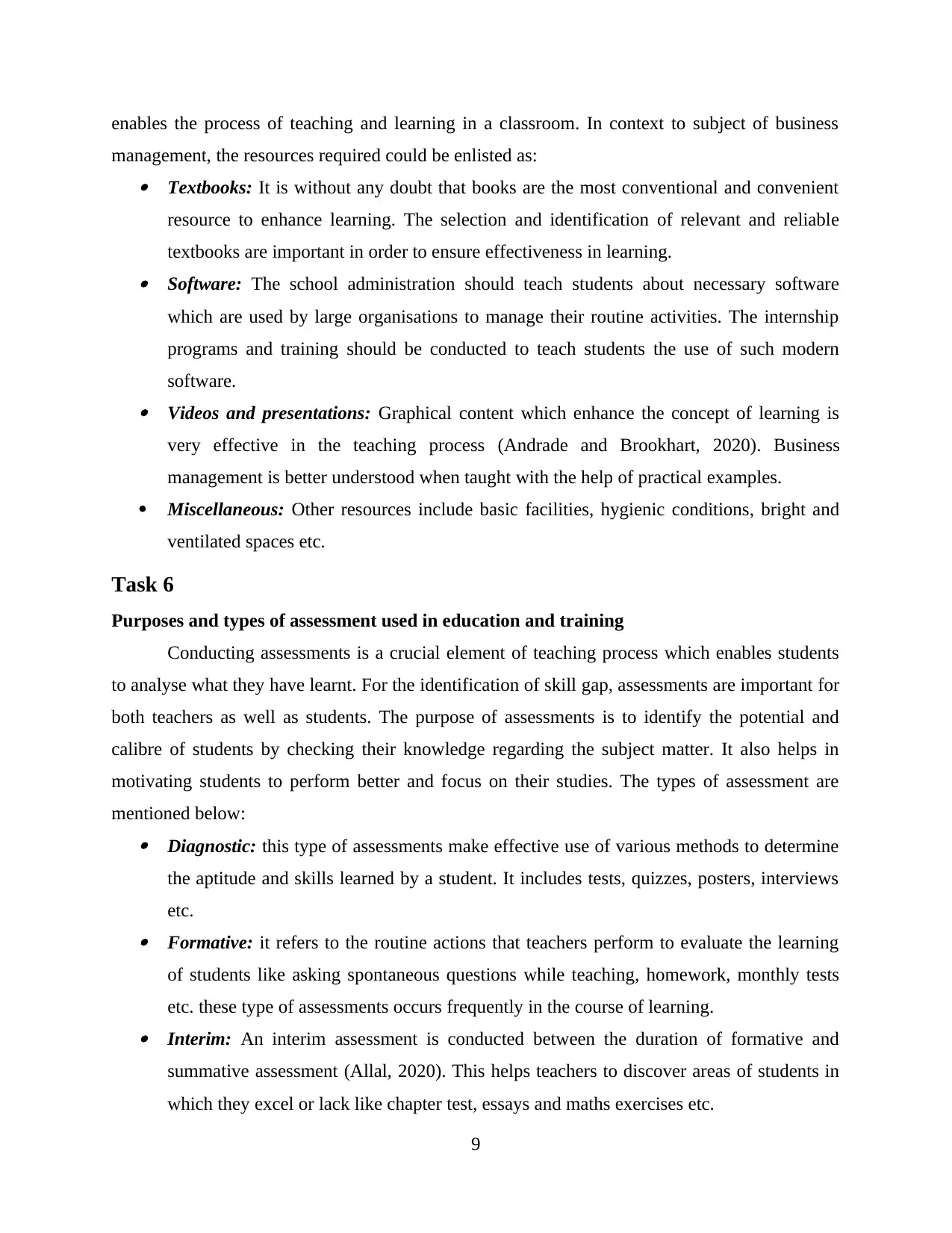
enables the process of teaching and learning in a classroom. In context to subject of business
management, the resources required could be enlisted as: Textbooks: It is without any doubt that books are the most conventional and convenient
resource to enhance learning. The selection and identification of relevant and reliable
textbooks are important in order to ensure effectiveness in learning. Software: The school administration should teach students about necessary software
which are used by large organisations to manage their routine activities. The internship
programs and training should be conducted to teach students the use of such modern
software. Videos and presentations: Graphical content which enhance the concept of learning is
very effective in the teaching process (Andrade and Brookhart, 2020). Business
management is better understood when taught with the help of practical examples.
Miscellaneous: Other resources include basic facilities, hygienic conditions, bright and
ventilated spaces etc.
Task 6
Purposes and types of assessment used in education and training
Conducting assessments is a crucial element of teaching process which enables students
to analyse what they have learnt. For the identification of skill gap, assessments are important for
both teachers as well as students. The purpose of assessments is to identify the potential and
calibre of students by checking their knowledge regarding the subject matter. It also helps in
motivating students to perform better and focus on their studies. The types of assessment are
mentioned below: Diagnostic: this type of assessments make effective use of various methods to determine
the aptitude and skills learned by a student. It includes tests, quizzes, posters, interviews
etc. Formative: it refers to the routine actions that teachers perform to evaluate the learning
of students like asking spontaneous questions while teaching, homework, monthly tests
etc. these type of assessments occurs frequently in the course of learning. Interim: An interim assessment is conducted between the duration of formative and
summative assessment (Allal, 2020). This helps teachers to discover areas of students in
which they excel or lack like chapter test, essays and maths exercises etc.
9
management, the resources required could be enlisted as: Textbooks: It is without any doubt that books are the most conventional and convenient
resource to enhance learning. The selection and identification of relevant and reliable
textbooks are important in order to ensure effectiveness in learning. Software: The school administration should teach students about necessary software
which are used by large organisations to manage their routine activities. The internship
programs and training should be conducted to teach students the use of such modern
software. Videos and presentations: Graphical content which enhance the concept of learning is
very effective in the teaching process (Andrade and Brookhart, 2020). Business
management is better understood when taught with the help of practical examples.
Miscellaneous: Other resources include basic facilities, hygienic conditions, bright and
ventilated spaces etc.
Task 6
Purposes and types of assessment used in education and training
Conducting assessments is a crucial element of teaching process which enables students
to analyse what they have learnt. For the identification of skill gap, assessments are important for
both teachers as well as students. The purpose of assessments is to identify the potential and
calibre of students by checking their knowledge regarding the subject matter. It also helps in
motivating students to perform better and focus on their studies. The types of assessment are
mentioned below: Diagnostic: this type of assessments make effective use of various methods to determine
the aptitude and skills learned by a student. It includes tests, quizzes, posters, interviews
etc. Formative: it refers to the routine actions that teachers perform to evaluate the learning
of students like asking spontaneous questions while teaching, homework, monthly tests
etc. these type of assessments occurs frequently in the course of learning. Interim: An interim assessment is conducted between the duration of formative and
summative assessment (Allal, 2020). This helps teachers to discover areas of students in
which they excel or lack like chapter test, essays and maths exercises etc.
9
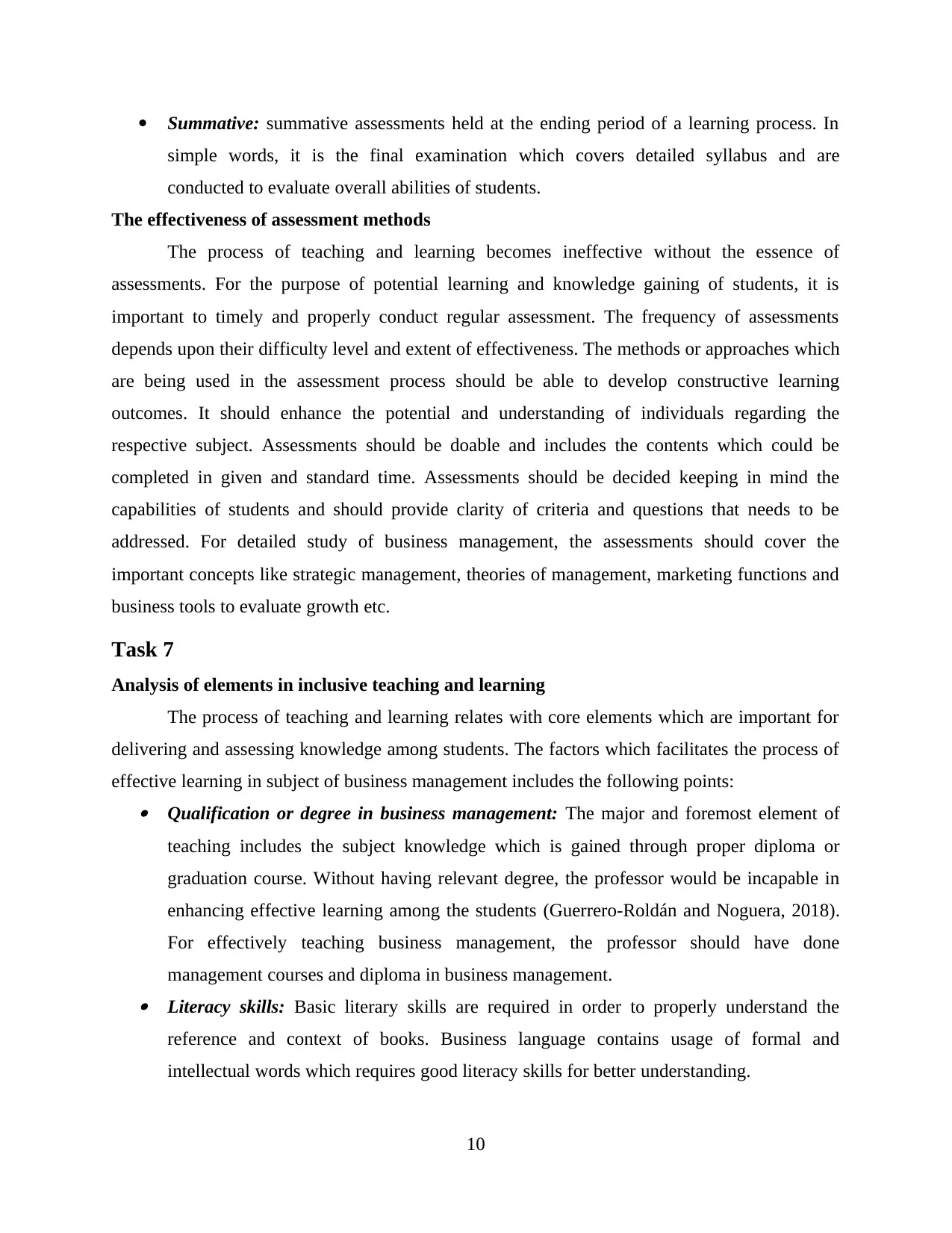
Summative: summative assessments held at the ending period of a learning process. In
simple words, it is the final examination which covers detailed syllabus and are
conducted to evaluate overall abilities of students.
The effectiveness of assessment methods
The process of teaching and learning becomes ineffective without the essence of
assessments. For the purpose of potential learning and knowledge gaining of students, it is
important to timely and properly conduct regular assessment. The frequency of assessments
depends upon their difficulty level and extent of effectiveness. The methods or approaches which
are being used in the assessment process should be able to develop constructive learning
outcomes. It should enhance the potential and understanding of individuals regarding the
respective subject. Assessments should be doable and includes the contents which could be
completed in given and standard time. Assessments should be decided keeping in mind the
capabilities of students and should provide clarity of criteria and questions that needs to be
addressed. For detailed study of business management, the assessments should cover the
important concepts like strategic management, theories of management, marketing functions and
business tools to evaluate growth etc.
Task 7
Analysis of elements in inclusive teaching and learning
The process of teaching and learning relates with core elements which are important for
delivering and assessing knowledge among students. The factors which facilitates the process of
effective learning in subject of business management includes the following points: Qualification or degree in business management: The major and foremost element of
teaching includes the subject knowledge which is gained through proper diploma or
graduation course. Without having relevant degree, the professor would be incapable in
enhancing effective learning among the students (Guerrero-Roldán and Noguera, 2018).
For effectively teaching business management, the professor should have done
management courses and diploma in business management. Literacy skills: Basic literary skills are required in order to properly understand the
reference and context of books. Business language contains usage of formal and
intellectual words which requires good literacy skills for better understanding.
10
simple words, it is the final examination which covers detailed syllabus and are
conducted to evaluate overall abilities of students.
The effectiveness of assessment methods
The process of teaching and learning becomes ineffective without the essence of
assessments. For the purpose of potential learning and knowledge gaining of students, it is
important to timely and properly conduct regular assessment. The frequency of assessments
depends upon their difficulty level and extent of effectiveness. The methods or approaches which
are being used in the assessment process should be able to develop constructive learning
outcomes. It should enhance the potential and understanding of individuals regarding the
respective subject. Assessments should be doable and includes the contents which could be
completed in given and standard time. Assessments should be decided keeping in mind the
capabilities of students and should provide clarity of criteria and questions that needs to be
addressed. For detailed study of business management, the assessments should cover the
important concepts like strategic management, theories of management, marketing functions and
business tools to evaluate growth etc.
Task 7
Analysis of elements in inclusive teaching and learning
The process of teaching and learning relates with core elements which are important for
delivering and assessing knowledge among students. The factors which facilitates the process of
effective learning in subject of business management includes the following points: Qualification or degree in business management: The major and foremost element of
teaching includes the subject knowledge which is gained through proper diploma or
graduation course. Without having relevant degree, the professor would be incapable in
enhancing effective learning among the students (Guerrero-Roldán and Noguera, 2018).
For effectively teaching business management, the professor should have done
management courses and diploma in business management. Literacy skills: Basic literary skills are required in order to properly understand the
reference and context of books. Business language contains usage of formal and
intellectual words which requires good literacy skills for better understanding.
10
⊘ This is a preview!⊘
Do you want full access?
Subscribe today to unlock all pages.

Trusted by 1+ million students worldwide
1 out of 18
Related Documents
Your All-in-One AI-Powered Toolkit for Academic Success.
+13062052269
info@desklib.com
Available 24*7 on WhatsApp / Email
![[object Object]](/_next/static/media/star-bottom.7253800d.svg)
Unlock your academic potential
Copyright © 2020–2025 A2Z Services. All Rights Reserved. Developed and managed by ZUCOL.



